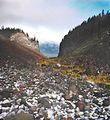This is an old revision of this page, as edited by EncMstr (talk | contribs) at 08:45, 9 August 2006 (→External links: wilderness expansion debated by mountain bicyclists). The present address (URL) is a permanent link to this revision, which may differ significantly from the current revision.
Revision as of 08:45, 9 August 2006 by EncMstr (talk | contribs) (→External links: wilderness expansion debated by mountain bicyclists)(diff) ← Previous revision | Latest revision (diff) | Newer revision → (diff)| Mount Hood Wilderness | |
|---|---|
| IUCN category Ib (wilderness area) | |
| Location | Oregon, USA |
| Nearest city | Portland, OR |
| Area | 47,160 acres (190 km²) |
| Established | 1964 |
| Governing body | U.S. Forest Service |
The Mount Hood Wilderness is a protected wilderness area inside the Mount Hood National Forest which is located in the U.S. state of Oregon. The area, about 47,000 acres (190 km²), includes the peak of Mount Hood and its upper slopes, and ranges from temperate rain forests at the lower elevations, to glaciers and rocky ridges at higher elevations.
The wilderness wraps around the mountain from west to northeast, and borders Timberline lodge and Mt. Hood Meadows ski lifts which occupy some of the south and east slopes of the mountain.
Trails
Journeys to the summit are popular, but not for everyone. Mount Hood offers experienced and novice mountaineers opportunities to traverse glaciers, snowfields, steep volcanic soil, and deal with rapidly changing and difficult to predict weather.
Numerous established hiking trails traverse the treed portion of the area. Trailheads circle the mountain, from Lolo pass (which the Pacific Crest Trail crosses) to Cloud Cap to all the ski areas. There are several historic structures (predating the wilderness designation), one of which is the stone lodge near Cairn Basin.
The best known trail is the forty-one mile Timberline trail which circles the mountain. The trail, Forest Service trail #600, shares thirteen miles with the Pacific Crest Trail and alternates above and below the timberline. The trail is rerouted periodically to avoid sensitive high altitude and alpine meadows. It has a handful of informal campsites for backpackers, although camping is permitted anywhere outside the meadows and at least 200 feet from water bodies. There are several hazardous stream crossings, especially on the west side. The trail has several significant vertical ascents and descents—mostly at canyon crossings—of as much as 5,000 vertical feet. The trail is accessible from Timberline Lodge, which has free parking for backpackers, or numerous connecting trails.
Restrictions
Wilderness permits are required, but free, to enter the area and can be filled out at ranger stations or at kiosks along trails where they enter the wilderness.
Wilderness areas do not allow motorized or mechanical equipment including bicycles. Although camping and fishing are allowed with proper permit, no roads or buildings are constructed and there is also no logging or mining, in compliance with the 1964 Wilderness Act. Wilderness areas within National Forests and Bureau of Land Management areas also allow hunting in season.
Images
-
 A Glaciated valley on the west side of the mountain.
A Glaciated valley on the west side of the mountain.
-
 Temperate rain forests on the west side of the mountain.
Temperate rain forests on the west side of the mountain.
-
 The head waters of the Sandy River.
The head waters of the Sandy River.
-
 Ramona Falls
Ramona Falls
External links
- Mount Hood Wilderness information
- Topozone map
- Satellite image (Google Mapping)
- Mountain Bicycling enthusiast BicyclingPaper.com controversy expanding Mount Hood Wilderness by Template:AcreAndHectare.